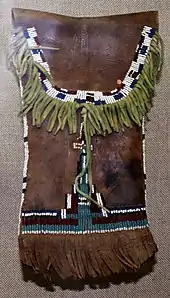Beadwork
Beadwork is the art or craft of attaching beads to one another by stringing them with a sewing needle or beading needle and thread or thin wire, or sewing them to cloth.[1] Beads come in a variety of materials, shapes and sizes. Beads are used to create jewelry or other articles of personal adornment; they are also used in wall hangings and sculpture and many other artworks.
.jpg.webp)
Beadwork techniques are broadly divided into loom and off-loom weaving, stringing, bead embroidery, bead crochet, bead knitting, and bead tatting.[2]
Beads, made of durable materials, survive in the archaeological record appearing with the very advent of modern man, Homo sapiens.[3]
Beads are used for religious purposes, as good luck talismans, for barter, and as curative or medicinal agents.
Modern beading
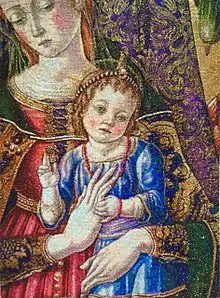
Modern beadwork is often used as a creative hobby to create jewelry, handbags, coasters, plus other crafts. Beads are available in different designs, sizes, colors, shapes, and materials, allowing much variation among bead artisans and projects. Simple projects can be created in less than an hour by novice beaders, while complex beadwork may take weeks of meticulous work with specialized tools and equipment.
There are many contemporary artists who use beads as a medium. Some of those artist include Liza Lou, Ran Hwang, Hew Locke, Cherice Harrison- Nelson, Jeffery Gibson, and Joyce J. Scott.
Liza Lou began her career in 1969 and is based in Los Angeles, California and South Africa. Her most notable work was Kitchen (1991-96) which was a life size model of a domestic kitchen with dirty dishes, frying egg, and cooling pie. Every inch of the work was covered in glass beads. The structure of the work was wood and papier-mâché.[4]
Ran Hwang is based in Seoul, South Korea and New York, New York. Her work combines beads, buttons and crystals into compositions featuring cherry blossoms, palaces, and birds in flight. Hwang states that "the core of [her] practice is to enliven these tiny beautiful objects"[4]
Hew Locke started in 1959 and his art practice is based out of London England. He first started incorporating beads into his work by using strings of beads. He uses cheap beads found in discount stores and tries to elevate the poor material to high art. [4]
Cherice Harrison-Nelson began her career in 1959 in New Orleans, Louisiana. She is also a co-founder and curator of the Mardi Gras Indian Hall of Fame. Her suits address social issues and refer to her West African ancestry. [4]
Jeffery Gibson started in 1972 out of New York, New York. He first started using beads in his undergraduate time at the School of the Art Institute of Chicago. Thinking of beads as sculptural objects he uses this medium that ties him to his roots. [4]
Joyce J. Scott began her artist career in 1948 in Baltimore, Maryland. Her work confronts classism, racism and misogyny. She sees beadwork as an ancient skill that she must be worthy of. Her work routinely incorporating glasswork and found objects. [4]
Ancient beading
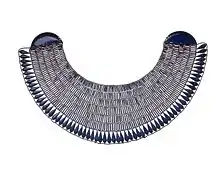
Faience is a mixture of powdered clays and lime, soda and silica sand. This is mixed with water to make a paste and molded around a small stick or bit of straw. It is then ready to be fired into a bead. As the bead heats up, the soda, sand and lime melt into glass that incorporates and covers the clay. The result is a hard bead covered in bluish glass.
This process was probably discovered first in Mesopotamia and then imported to ancient Egypt. However, it was the Egyptians who made it their own art form. Since before the 1st dynasty of Narmer (3100 B.C.) to the last dynasty of the Ptolemaic Kingdom (33 B.C.) and to the present day, faience beads have been made in the same way.
These beads predate glass beads and were probably a forerunner of glass making. If a beadmaker was a little short of clay and had a little extra lime and the fire was hotter than usual, the mixture would become glass. In fact some early tubular faience beads are clayish at one end and pure glass at the other end. Apparently the beads weren't fired evenly.
The uneven beads were noticed early on, this led to experimentation, slowly at first. It took a long time for new ideas to be accepted in a conservative, agricultural society. One of the first variations to take hold was to color the faience beads by adding metallic salts. By the beginning of the eighteenth dynasty (1850 B.C.), faience making and glass making had become two separate crafts.
Faience beads were so common because they were cheaper and less labor-intensive to make than stone beads. Aside from personal use and daily wear they were used to create beaded netting to cover mummies. Most of the archaeological specimens come from burials.[5]
As early as the Old Kingdom (circa 2670–2195 B.C.), Egyptian artisans fashioned images of gods, kings, and mortals wearing broad collars made of molded tubular and teardrop beads. These beaded collars may have been derived from floral prototypes. In antiquity the collar was called a wesekh, literally "the broad one".[6]
In the Americas, the Cherokee used bead work to tell stories. They told them by the patterns in the beads. They used dried berries, gray Indian corn, teeth, bones, claws, or sometimes sea shells when they traded with coastal tribes.[7][8]
3D beading
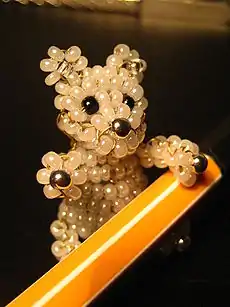
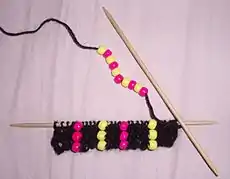
3D beading generally uses the techniques of bead weaving, which can be further divided into right angle weave and peyote stitch.
Many 3D beading patterns are done in right angle weave, but sometimes both techniques are combined in the same piece. Both stitches are done using either fishing line or nylon thread. Fishing line lends itself better to right angle weave because it is stiffer than nylon thread, so it holds the beads in a tighter arrangement and does not easily break when tugged upon.
Nylon thread is more suited to peyote stitch because it is softer and more pliable than fishing line, which permits the beads of the stitch to sit straight without undue tension bending the arrangement out of place. Two needle right angle weave is done using both ends of the fishing line, in which beads are strung in repeated circular arrangements, and the fishing line is pulled tight after each bead circle is made. Single needed right angle weave was popularized in the 1990s by David Chatt and has become the norm.
Peyote stitch is stitched using only one end of the nylon thread. The other end of the string is left dangling at the beginning of the piece, while the first end of the thread progresses through the stitch. In peyote stitch, beads are woven into the piece in a very similar fashion to knitting or cross stitching.
In fact, it is not uncommon for cross stitch patterns to be beaded in peyote stitch technique. Peyote stitch patterns are very easy to depict diagrammatically because they are typically stitched flat.
Right angle weave lends itself better to 3D beading, but peyote stitch offers the advantage of allowing the beads to be more tightly knit, which is sometimes necessary to portray an object properly in three dimensions.
European beadwork
Beadwork in Europe has a history dating back millennia to a time when shells and animal bones were used as beads in necklaces.
Glass beads were being made in Murano by the end of the 14th century. French beaded flowers were being made as early as the 16th century, and lampwork glass was invented in the 18th century. Seed beads began to be used for embroidery, crochet, and numerous off-loom techniques.
Native American beadwork
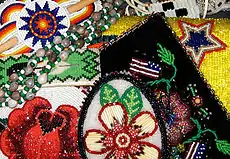
Beadwork is a Native American art form which evolved to mostly use glass beads imported from Europe and recently Asia. Glass beads have been in use for almost five centuries in the Americas. Today a wide range of beading styles flourish.
Alongside the widespread popularity of glass beads, bead artists continue incorporating natural items such as dyed porcupine quills, shell such as wampum, and dendrite, and even sea urchin spines in a similar manner as beads.
Wampum shell beads are ceremonially and politically important to a range of Eastern tribes,[9] and were used to depict several important treaties between the Native peoples and the colonists, as in the case of the Two Row Wampum Treaty.
In the Great Lakes, Ursuline nuns introduced floral patterns to tribes who quickly applied them to beadwork.[10] Great Lakes tribes are known for their bandolier bags that might take an entire year to complete.[11] During the 20th century the Plateau tribes, such as the Nez Perce, perfected contour-style beadwork in which the lines of beads are stitched to emphasize the pictorial imagery. Plains tribes are master beaders, and today dance regalia for men and women feature a variety of beadwork styles. While Plains and Plateau tribes are renowned for their beaded horse trappings, Subarctic tribes such as the Dene create lavish beaded floral dog blankets.[12] Eastern tribes have a completely different beadwork aesthetic: Innu, Mi'kmaq, Penobscot, and Haudenosaunee tribes are known for symmetrical scroll motifs in white beads, called the "double curve."[13] Iroquois are also known for "embossed" beading in which strings pulled taut force beads to pop up from the surface, creating a bas-relief. Tammy Rahr (Cayuga) is a contemporary practitioner of this style. Zuni artists have developed a tradition of three-dimensional beaded sculptures.
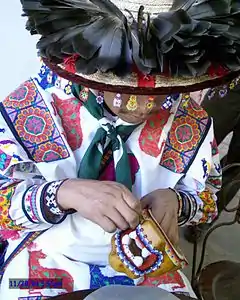
Huichol Indians of Jalisco and Nayarit, Mexico have a completely unique approach to beadwork. They adhere beads one by one to a surface such as wood or a gourd with a mixture of resin and beeswax.[14]
Most Native beadwork is created for tribal use, but beadworkers also create conceptual work for the art world. Richard Aitson (Kiowa-Apache), enjoying both an Indian and non-Indian audience, is known for his fully beaded cradleboards. Another Kiowa beadworker, Teri Greeves, has won top honors for her beadwork which consciously integrates both traditional and contemporary motifs such as beaded dancers on Converse high-tops. Greeves also beads on buckskin and explores such issues as warfare or Native American voting rights.[15]
Marcus Amerman, Choctaw, one of today's most celebrated bead artists, pioneered a movement of highly realistic beaded portraits.[16] His imagery ranges from 19th century Native leaders to pop icons including Janet Jackson and Brooke Shields.
Roger Amerman, Marcus' brother, and Martha Berry, Cherokee, have effectively revived Southeastern beadwork, a style that had been lost because of the forced removal of their tribes to Indian Territory. Their beadwork commonly features white bead outlines, an echo of the shell beads or pearls Southeastern tribes used before contact.[17]
Jamie Okuma (Luiseño-Shoshone-Bannock) has won top awards with her beaded dolls, which can include entire families or horses and riders, all with fully beaded regalia. The antique Venetian beads she uses can be as small as size 22°, about the size of a grain of salt.[18] Juanita Growing Thunder Fogarty, Rhonda Holy Bear, and Charlene Holy Bear are also prominent beaded doll makers.
African beadwork
Many African nations have different beadworking traditions and techniques.
Cameroon
In Cameroon, women create wooden sculptures entirely covered with beads on their surfaces like skin. Beads were historically reserved for the king, so everyday objects like stools, bowls, and other items were elevated out of the ordinary by male artists by adding beadwork. These beaded works are now made by women for anyone who can afford them. There is a historical social power of beads and their trading commerce, including the religious symbolism of cowrie shell beads with women’s fertility. European beads were deemed extremely valuable and were used for trading in slave trades.
Contemporary beadwork sculptures are seen as transition pieces, as Cameroon has seen its own transition from colonialism to independence. A cooperative of women served as an outlet for sales and gave an economic supplement to women’s farming activities. There is an intricate and detailed process the women execute to create these beaded skins for their wooden sculptures. Depending on size and skill level, works could take anywhere from a few days, to a week, to even one year for an extremely difficult piece. The prices of the beaded objects were not fixed and bargaining was to be expected before every purchase. Although most women bead to make money, they also take a tremendous amount of pride and pleasure from their work and they are made with heart.[19]
See also
References
- "Beadwork". Merriam-Webster. Retrieved 3 May 2014.
- Libin, Nina (1998). Tatted Lace of Beads, the Techniques of BEANILE LACE. Berkeley, CA: LACIS. p. 112. ISBN 0-916896-93-5.
- Dubin, Lois Sherr (2009). The History of Beads: From 100,000 B.C. to the Present. New York: Harry N. Abrams. p. 16. ISBN 978-0810951747.
- Gittlen, Ariela (16 February 2018). "6 Artists Turning Beads into Spellbinding Works of Art". Artsy. Retrieved 19 October 2020.
- Fernandes, Beverly. "Faience Beads from Egypt". Retrieved 17 June 2014.
- "Broad Collar". Retrieved 17 June 2014.
- "Native American Art- Cherokee Beadwork and Basketry". nativeamerican-art.com. Retrieved 14 November 2017.
- Cherokee, Eastern Band of. "Cherokee Indian Beadwork and Beading Patterns | Cherokee, NC". Cherokee, NC. Retrieved 14 November 2017.
- Dubin, p. 170-171
- Dubin, p. 50
- Dubin, p. 218
- Berlo and Philips, p. 151
- Berlo and Phillips, p. 146
- Hillman, Paul. "The Huichol Web of Life: Creation and Prayer | Lesson Two: Jicaras, Kukus and Seeds". Community Arts Resource Exchange. The Bead Museum. Archived from the original on 18 May 2008. Retrieved 13 March 2009.
- Lopez, Antonio (August 2000). "Focus on Native Artists | Teri Greeves". Southwest Art Magazine. Retrieved 13 March 2009.
- Berlo and Phillips, p. 32
- Berlo and Phillips, p. 87
- Indyke, Dottie (May 2001). "Native Arts | Jamie Okuma". Southwest Art Magazine. Retrieved 13 March 2009.
- LaDuke, Betty. (1997). Africa : women's art, women's lives. Trenton, NJ: Africa World Press. pp. 63–84. ISBN 0-86543-434-4. OCLC 35521674.
- Berlo, Janet C.; Ruth B. Phillips (1998). Native North American Art. Oxford History of Art. Oxford University Press. ISBN 978-0-19-284218-3.
- Dubin, Lois Sherr (1999). North American Indian Jewelry and Adornment: From Prehistory to the Present. New York: Harry N. Abrams. ISBN 0-8109-3689-5
- Dubin, Lois Sherr (2009). The History of Beads: From 100,000 B.C. to the Present. New York: Harry N. Abrams. ISBN 978-0810951747.
- Beads and beadwork. (1996). In Encyclopedia of north american indians, Houghton Mifflin. Retrieved January 27, 2014, from http://search.credoreference.com/
External links
| Wikimedia Commons has media related to Beadwork. |
| Wikivoyage has a travel guide for Bead shopping. |
